Mario Ferdelba French Antique Landscape Impressionist Oil Painting Old France 50
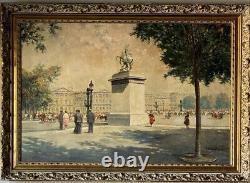
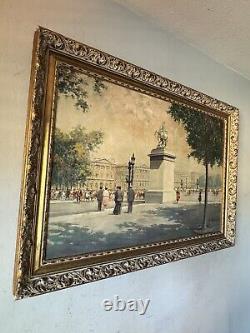
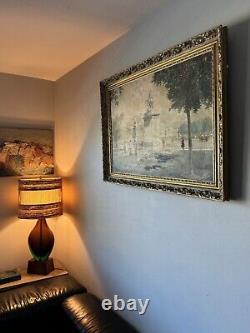
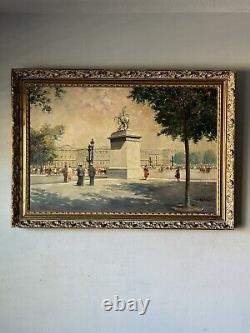
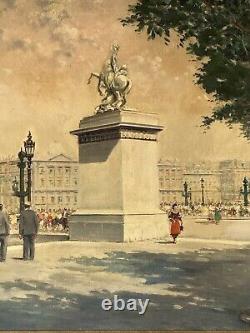
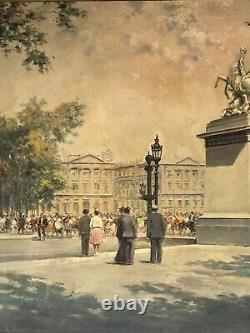
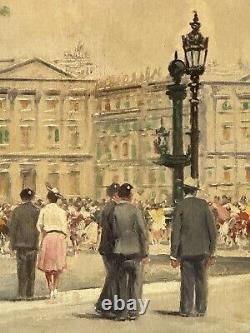
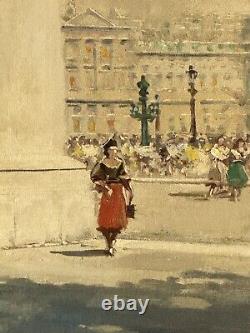
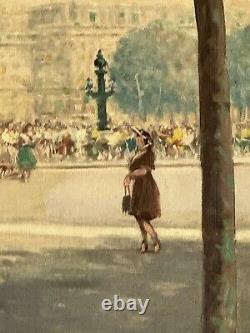
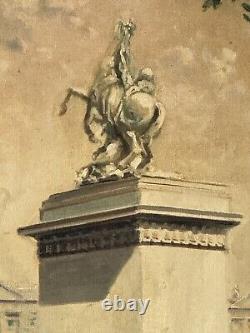
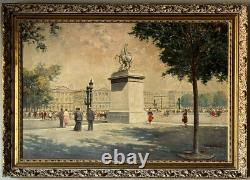
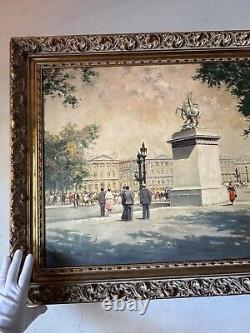

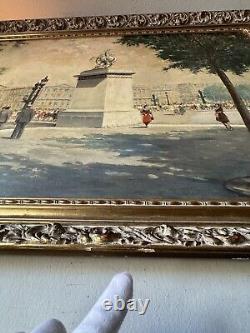
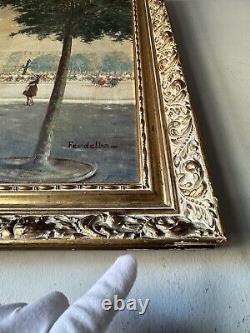
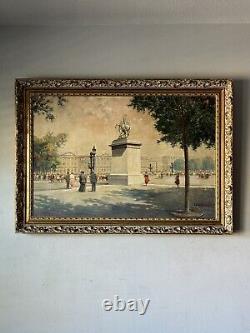
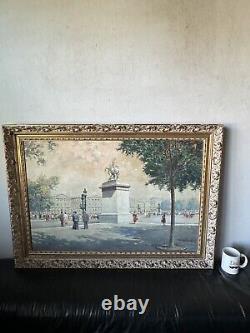

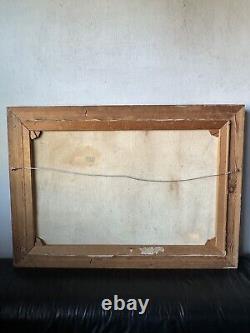
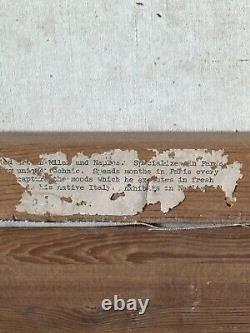
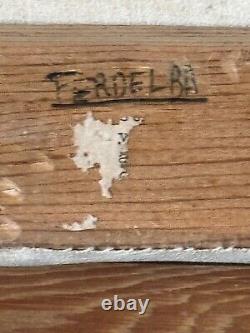
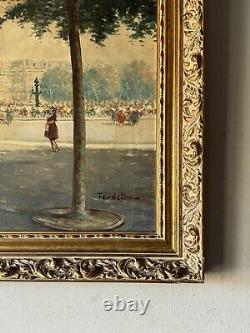
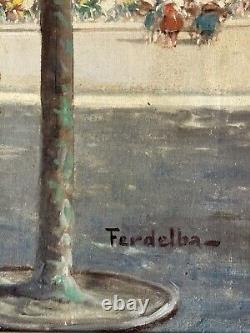


ENCHANTING AND CAPTIVATING ANTIQUE FRENCH IMPRESSIONIST OIL PAINTING ON CANVAS BY ESTEEMED ITALIAN PAINTER MARIO FERDELBA. THIS WORK DEPICTS THE TIMELESS ALLURE OF PLACE DE LA CONCORDE, LOCATED IN THE HEART OF PARIS.
THE SCENE UNFOLDS BENEATH THE DAPPLE SUNLIGHT OF A MAJESTIC ANCIENT TREE, ITS BRANCHES REACHING OUT LIKE A PROTECTIVE CANOPY. ELEGANT DRESSED FIGURES GATHERED AROUND THEIR ATTIRE REMINISCENT OF THE 1950s. IN THE FOREGROUND, THE ICONIC HORSE OF MARLY STATUE TAKES CENTER STAGE, BRILLIANTLY SCULPTED IN EXQUISITE DETAIL. THE STATUE, A SYMBOL OF POWER AND GRACE, STANDS PROUDLY ON ITS PEDESTAL, ADDING A SENSE OF GRANDEUR TO THE SCENE. BEHIND THE STATUE, IMPORTANT BUILDINGS OF PARIS RISE IN THE DISTANCE.MARIO FERDELBA DELICATE BRUSHSTROKES ARE CHARACTERISTIC OF THE IMPRESSIONIST STYLE. THE COLORS BLEND SEAMLESSLY, CREATING A HARMONIOUS PALETTE THAT DEPICTS THE TRANQUIL AMBIANCE OF A LATE AFTERNOON IN PARIS. THE DETAILS IN THIS PAINTING ARE SPOT-ON AND AMAZING. SIGNED BY MARIO FERDELBA IN THE LOWER RIGHTHAND CORNER. IT DATES AROUND THE 1950s.
DIMENSIONS INCLUDING THE FRAME: 30" H x 40" W. DIMENSIONS WITHOUT THE FRAME: 24" H x 36" W.
Mario Ferdelba is known for Painting. Mario Ferdelba was a 20th Century Italian artist, who was born in Naples, Italy famous for his street scenes of Naples and Florence, Italy as well as Paris, France. He often incorporates market scenes and always with a great color scheme. He passed away in 1971. The Place de la Concorde (French Concord Square') is one of the major public squares in Paris, France.Measuring 7.6 ha (19 acres) in area, it is the largest square in the French capital. It is located in the city's eighth arrondissement, at the eastern end of the Champs-Élysées. It was the site of many notable public executions, including those of King Louis XVI, Marie Antoinette and Maximilien Robespierre in the course of the French Revolution, during which the square was temporarily renamed the Place de la Révolution ('Revolution Square'). It received its current name in 1795 as a gesture of reconciliation in the later years of the revolution. The square was originally designed to be the site of an equestrian statue of King Louis XV, commissioned in 1748 by the merchants of Paris, to celebrate the recovery of King Louis XV from a serious illness.
The site chosen for the statue was the large esplanade, or space between the revolving gate the Tuileries Gardens and the Cour-la-Reine, a popular lane for horseback riding at the edge of the city. At the time, the Concorde bridge and the Rue de Rivoli did not exist, and the Rue Royale was a muddy lane that descended down to a marsh beside the Seine. The architect Ange-Jacques Gabriel made a plan for the site and the square was finished by 1772.
It was in the form of an octagon, bordered by a sort of moat twenty meters wide, crossed by stone bridges, and surrounded by a stone balustrade. At the eight corners Gabriel placed stone stairways to descend into the square, which was divided into flowerbeds.
In the center of the gardens was the pedestal on which the statue stood. The statue, by Bouchardon, depicted the King on horseback as the victor of the Battle of Fontenoy, dressed as a Roman general, with a laurel wreath on his head. On the four corners of the pedestal, designed by Jean Chalgrin, are bronze statues by Jean-Baptiste Pigalle, depicting the virtues of great monarchs; Force, Justice, Prudence, and Peace. The statue was dedicated on 20 June 1763, but by this time the King had lost much of his popularity.
A few days after its dedication, someone hung a placard on the statue, proclaiming: Oh, the beautiful statue! The Virtues are under the feet, and Vice is in the saddle! On the north side of the square, between 1760 and 1775, Gabriel planned and built two palatial buildings with identical facades.
The classical facades were inspired by those created by Charles Perrault, the royal architect, for the facade of the Louvre. They were originally intended to be occupied by embassies, but in the end the east building became a depot for the Royal furnishings, then the headquarters of the French Navy, the Hôtel de la Marine. The west building was divided into individual properties for the nobility. Beginning in 1789, the square was a central stage for the events of the French Revolution. On 13 July 1789, a mob came to the Hotel de la Marine and seized a store of weapons, including two old cannon, gifts from the King of Siam, which fired the first shots during the storming of the Bastille on 14 July 1789. On 11 August 1792, the statue of Louis XV was pulled down and taken to a foundry, where it was melted down. A few months later, a new statue, "Liberty", by the sculptor François-Frédéric Lemot, took its place; it was a figure wearing a red liberty cap and holding a lance. The Place Louis XV ("Louis XV Square") became the Place de la Revolution ("Revolution Square"). In October 1792, the first executions by guillotine in the square took place.The two people who were executed were thieves who had stolen the royal crown diamonds from the Hotel de la Marine. On 21 January 1793, King Louis XVI was executed there, followed in the same year on 16 October by Queen Marie Antoinette.
As the Reign of Terror commenced, the guillotine was set up again on 11 May 1793, midway between the Statue of Liberty and the turning bridge at the entrance to the Tuileries Gardens, and remained there for thirteen months. Of the 2,498 persons guillotined in Paris during the Revolution, 1,119 were executed on the Place de la Concorde, 73 on the Place de la Bastille and 1,306 on the Place de la Nation.
Besides Louis XVI and Marie Antoinette, others executed on the same site included Charlotte Corday and Madame du Barry. During the later days of the Reign of Terror in 1794, Georges Danton, Camille Desmoulins, Antoine Lavoisier, Maximilien Robespierre, and Louis de Saint-Just were executed there. The last executions, those of the Prairial riot participants, were carried out on the Place de la Concorde in May 1795. The Place de la Concorde in 1829, before the modifications by King Louis-Philippe. The erection of the Luxor Monument, 25 October 1836. In 1795, under the Directory, the square was renamed the Place de la Concorde ("Concord Square") as a gesture of reconciliation after the turmoil of the revolution.After the Bourbon Restoration of 1814, the name was changed back to the Place Louis XV, and in 1826 the square was renamed the Place Louis XVI ("Louis XVI Square"). In 1790, early in the French Revolution, the Concorde bridge was constructed, and, at the suggestion of Jacques-Louis David, the statues of the "Horses of Marly" by G. Cousteau, were placed on the north side, at the entrance of the Champs-Élysées. In 1806, Napoleon Bonaparte began to construct the Rue de Rivoli along the edge of the square.
Under King Louis-Philippe and his prefect of the Seine, Rambuteau, the square was remade. In 1832, Jacques Ignace Hittorff was named chief architect of the project. In October 1835 Hittorff installed the new centrepiece of the square, the Luxor Obelisk, a gift to the King from the vice-pasha of Egypt, Mehemet Ali.
It was hoisted into place, before a huge crowd, on October 25, 1836. Hittorff commissioned celebrated sculptors, including James Pradier and Jean-Pierre Cortot to make eight statues representing the major cities of France, which were placed in 1838 on columns which had earlier been put in place around the square by Gabriel.
These statues form something of a rudimentary map, such that when viewing the Place de la Concorde from a birdseye perspective, the north-eastern states represent north-eastern cities, in the appropriate arrangement relative to one another, and so on. [7] A ring of twenty columns with lanterns were put in place during the same time. Between 1836 and 1840, Hittorff erected two monumental fountains, the Fontaine Maritime to the side of the Seine, and the Fontaine Fluviale to the side of the Rue Royale. The design, consisting of two fountains each nine meters high, was modeled after that of the fountains of Saint-Peters Square in Rome. In 1853, under Napoleon III, the deep moats around the square, which had turned into rendez-vous points for prostitutes, were filled in. The square was the entry point of two major international expositions: the Paris Universal Exposition of 1900, which left behind the Grand Palais and the Petit Palais, and the 1925 International Exhibition of Modern Decorative and Industrial Arts, which gave its name to the Art Deco architectural style of the 20th century. It was also the site of great national celebrations, including the victory celebrations of the end of the First World War and the Liberation of Paris in the Second World War.A far-right demonstration in 1934 turned violent, with eleven deaths and two hundred injured. [10] It also hosted triumphant celebrations of sporting events such as the French National Team's victory in the FIFA World Cup of 1998.


